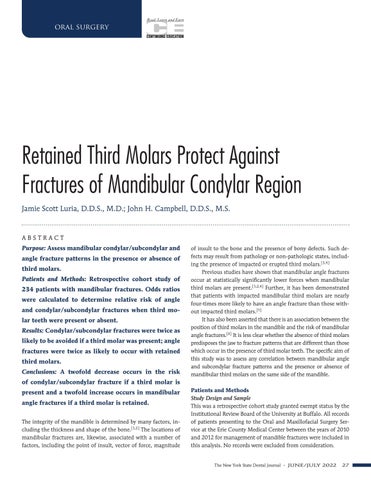oral surgery
Retained Third Molars Protect Against Fractures of Mandibular Condylar Region Jamie Scott Luria, D.D.S., M.D.; John H. Campbell, D.D.S., M.S.
ABSTRACT Purpose: Assess mandibular condylar/subcondylar and angle fracture patterns in the presence or absence of third molars. Patients and Methods: Retrospective cohort study of 234 patients with mandibular fractures. Odds ratios were calculated to determine relative risk of angle and condylar/subcondylar fractures when third molar teeth were present or absent. Results: Condylar/subcondylar fractures were twice as likely to be avoided if a third molar was present; angle fractures were twice as likely to occur with retained third molars. Conclusions: A twofold decrease occurs in the risk
of insult to the bone and the presence of bony defects. Such defects may result from pathology or non-pathologic states, including the presence of impacted or erupted third molars.[3,4] Previous studies have shown that mandibular angle fractures occur at statistically significantly lower forces when mandibular third molars are present.[1,2,4] Further, it has been demonstrated that patients with impacted mandibular third molars are nearly four-times more likely to have an angle fracture than those without impacted third molars.[5] It has also been asserted that there is an association between the position of third molars in the mandible and the risk of mandibular angle fractures.[6] It is less clear whether the absence of third molars predisposes the jaw to fracture patterns that are different than those which occur in the presence of third molar teeth. The specific aim of this study was to assess any correlation between mandibular angle and subcondylar fracture patterns and the presence or absence of mandibular third molars on the same side of the mandible.
of condylar/subcondylar fracture if a third molar is present and a twofold increase occurs in mandibular angle fractures if a third molar is retained. The integrity of the mandible is determined by many factors, including the thickness and shape of the bone.[1,2] The locations of mandibular fractures are, likewise, associated with a number of factors, including the point of insult, vector of force, magnitude
Patients and Methods Study Design and Sample This was a retrospective cohort study granted exempt status by the Institutional Review Board of the University at Buffalo. All records of patients presenting to the Oral and Maxillofacial Surgery Service at the Erie County Medical Center between the years of 2010 and 2012 for management of mandible fractures were included in this analysis. No records were excluded from consideration.
The New York State Dental Journal
●
JUNE/JULY 2022
27




